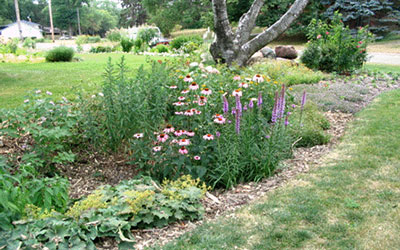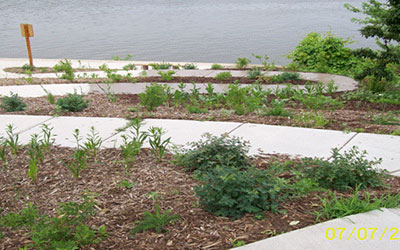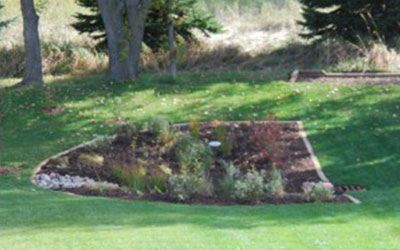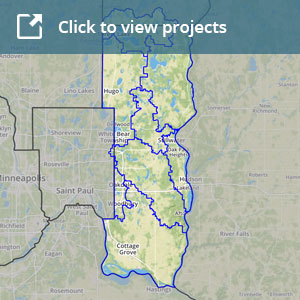The South Washington Watershed District (SWWD) Clean Water and Watershed Resiliency Cost Share Program offers financial assistance to encourage and enable citizens, municipalities, and businesses to use innovative practices to protect and improve lakes and streams within the district.
Opportunities for regional water quality improvement projects are limited and difficult to coordinate. Opportunities for smaller projects, however, exist on every residential, municipal, and commercial property. The South Washington Watershed District (SWWD) Clean Water and Watershed Resiliency Cost Share Program offers financial assistance to encourage and enable citizens, municipalities, and businesses to use innovative practices to protect and improve lakes and streams and support overall watershed health within the district. This program promotes water quality improvement by focusing on the reduction of phosphorus in stormwater runoff. Each pound of phosphorus, a nutrient critical to algae growth, removed from stormwater runoff can prevent up to 500 pounds of algae in our lakes, streams, and rivers. In addition, the program offers incentives for individuals and organizations to install landscape resiliency improvements that support the overall health of the watershed.
Eligibility:
The BMP Clean Water and Watershed Resiliency Cost-Share Program is a reimbursement program. Applicants must apply for funding, be approved by the SWWD Board of Managers, and have a signed contract prior to beginning the project.
Those eligible for cost share funding include:
- Residents of the SWWD
- Not-for-profit and religious organizations serving the SWWD
- Local Government Agencies serving the SWWD
- Public and private schools located within the SWWD
- Businesses and corporations located within the SWWD
Applicants who have received previous cost funding must wait one year after the close out (completion and payment) of a project, before applying for additional project funds.
Available Program Track and Funds:
The SWWD has allocated $70,000.00 for the BMP Clean Water and Watershed Resiliency Cost Share Program for 2025. With the goal of reducing phosphorus loading to SWWD lakes, streams, and rivers by 20 pounds, SWWD has set the 2025 funding rate at $5,000.00 per pound of phosphorus treated or retained on site. Water Quality projects may include but are not limited to raingardens and other stormwater filtration projects, gully repair, stream/streambank restoration projects and water management. This funding typically covers approximately 50% of a standard residential raingarden. The SWWD will accept funding applications year round until funds are depleted for the calendar year.
For landowners interested in projects where pollutant reduction calculations are difficult to determine, the SWWD provides support for Watershed Resiliency projects. These projects provide a range of watershed benefits that include habitat improvements for aquatic and terrestrial species, soil building to support infiltration and water holding capacity and invasive species removal in support of native plant community restoration, among others. Where measurable improvements to water quality can be determined, project funding will be based on Clean Water Cost Share determination. This may include restoration projects that involve removal of invasive species where soil integrity is compromised, or conversion from agricultural lands or turf to permanent native perennial vegetation. For these restoration projects, SWWD funding will only pay for plant material native to the region.
For landowners interested in projects determined by SWWD as having little potential for phosphorus treated on site (e.g. small residential native planting/raingarden), the SWWD offers a small grants track. The small grants track offers eligible projects free site visit, free concept-level design service, and up to $500 for eligible project installation materials. The SWWD will accept funding applications year round until funds are depleted for the calendar year.
Project Design and Estimate of Benefits:
An estimate of water quality benefits (phosphorus reduction) will be completed by SWWD staff using methods outlined in the MN Stormwater Manual. The estimate serves as the basis for determining the amount of reimbursement and will be provided to the applicant prior to submission of an application. Staff may require access to the site to complete the estimate.
Initial site visits are free of charge with eligible projects receiving free design assistance through SWWD. SWWD staff will work with applicants to develop a concept plan that maximizes benefit to our lakes and streams and complete all documentation necessary to apply for cost share funding. Upon completion of the project concept plan, staff will also provide the applicant with an estimate of the reduction of phosphorus leaving the site, which serves as the basis for determining the size of the cost share grant.
Applicants are allowed to use a designer other than the SWWD staff – contact SWWD for an estimate of phosphorus reduction benefits prior to applying for funding.
Reimbursement and Eligible Expenses:
Applicants must apply for funding, be approved by the SWWD Board of Managers, and have a signed contract prior to beginning their project.
This is a reimbursement program. After completion of the project and verification by SWWD staff that the feature is functioning, funds will be dispersed to program participant(s). In no cases will the reimbursement exceed the total project cost. Total project cost will be calculated by SWWD. In calculation of total project cost:
-Only those expenses with itemized receipts or invoices will be included
-SWWD does not reimburse applicants for their own labor costs
Cost share applicants are responsible for submittal of all required information, including: a completed application and sketch of the project. All necessary information will be provided by SWWD staff for projects they design. Additional information, if needed, will be requested by SWWD staff. Upon submittal of complete application, the SWWD staff will review it for eligibility and completeness, and submit a funding recommendation to the SWWD Board of Managers, who make all final funding decisions. The SWWD Board of Managers reserves the right to deny an application for any reason. Incomplete applications will not be presented to the Board for review.
Funding Agreement
Projects that are awarded funding will enter into an agreement with SWWD. This agreement will stipulate the responsibilities and obligations of both the grant applicant and the SWWD. All applicants are responsible for ensuring all permits necessary for the work are secured.
Clean Water and Watershed Resiliency Cost-Share Application
Re-Application Process
Applicants must wait one year after the close out (completion and payment) of a project, before an additional project application request may be submitted.
If interested in applying, please complete the application and mail it to the address below.
South Washington Watershed District
Attn: Tony Randazzo
2302 Tower Drive
Woodbury, MN 55125
(651) 714-3717
tony.randazzo@swwdmn.gov
Visit www.BlueThumb.org to find garden plans, plant information and local nurseries and landscapers.
Have questions about the program before you apply? Contact Tony Randazzo at Tony. Randazzo@swwdmn.gov or (651) 714-3717
Examples of Eligible Projects

Rain Gardens
Rain water is captured and held for 48 hours enhancing soil infiltration by these shallow planted depressions. Location: Depressional areas “Soggy” spots in yards and parking lots. Water Quality Impact: Decrease overall water and sediment volumes.

Shoreline Buffer
Deeply rooted native plants and erosion- control measures stabilizes erosive shorelines and intercept polluted run-off. Location: Lakeshore, stream banks, and wetland frontages. Water Quality Impact: Increase water and habitat of adjacent lakes and streams.

Native Plantings
Native plants are adapted to the local climate and soil conditions. Native plants work well for many landscaping and wildlife habitat plantings, because once established, they seldom need watering, mulching, protection from frost or continuous mowing. Native plants provide nectar, pollen, and seeds that serve as food for native butterflies, birds and other animals.


